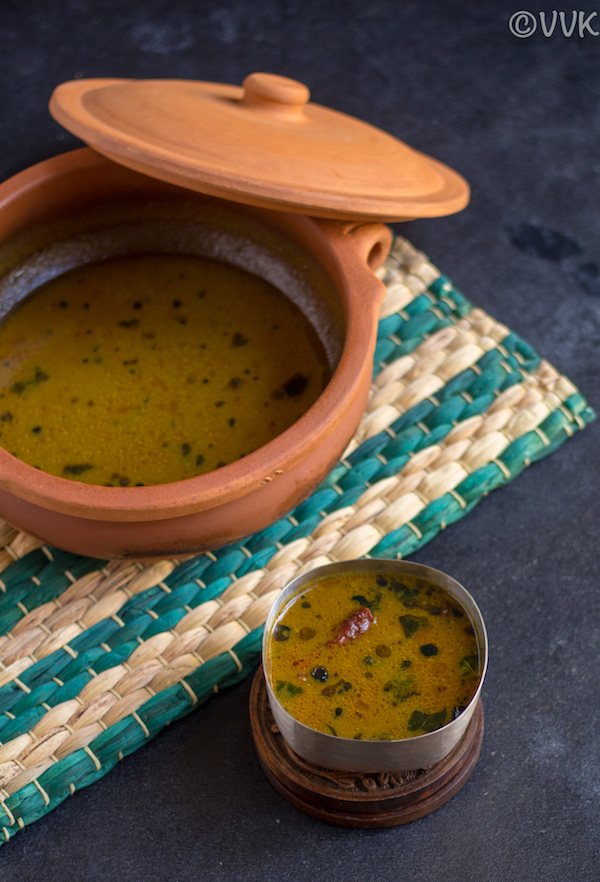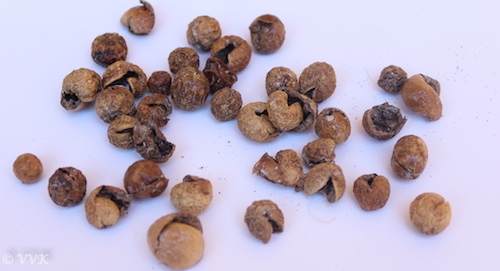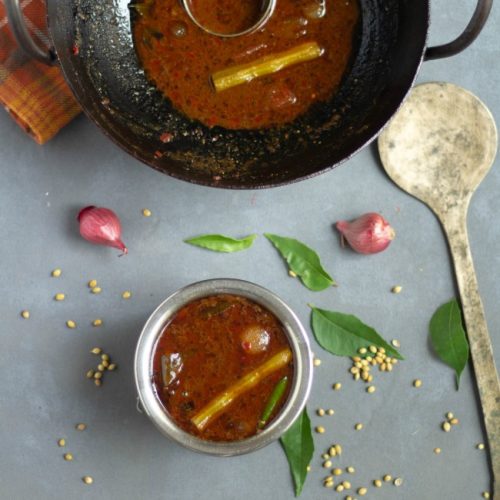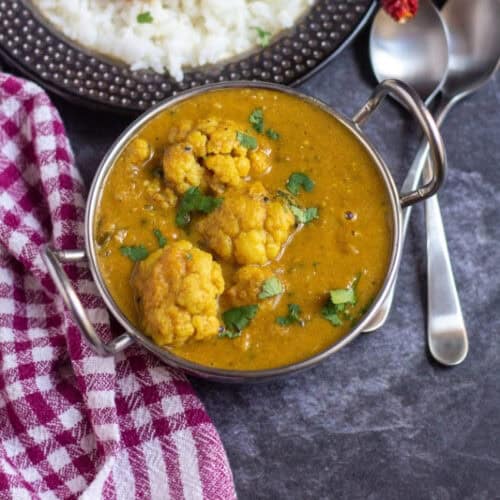Vathal Kuzhambu, precisely manathakkali vathal kuzhambu or vatha kuzhambu is a finger-licking spicy and tangy tamarind-based gravy with the dried sun berries or the black nightshade berries. Check out this authentic recipe from Tamil Nadu, with a detailed video.

Vathal Kuzhambu is a famous recipe from Tamil Nadu made with sundaikai vathal (turkey berries) or the manathakkali vathal (sun berries). My weekly menu is incomplete without the vathal kuzhambu. :-) Sundaikai vatha kuzhambu and manathakkali vatha kuzhambu are quite popular. But it doesn’t mean that you can make vatha kuzhambu only with these two ingredients.
Jump to:
Vathal
First, let us see what precisely vathal means?
Vathal is a Tamil word, meaning dried (sun-dried) vegetables. The veggies will be first soaked in salted yogurt or buttermilk or just salted water and then sun-dried. I have already posted okra vathal, karuvadagam, and karuvadagam vathal kuzhambu on my blog.
You can make vathals similarly with brinjal, cluster-beans, bitter gourd, etc. and you can use any of those vathals for this kuzhambu. But the taste varies depending upon the vathal that we add. Here are the pictures of the manathakkali vathal and the sundaikai vathal.


Kuzhambu
Kuzhambu (Tamil: குழம்பு) is again a Tamil word (pronounced as Ku-lam-bu), and there is no exact English word for it. Even Wikipedia says, tamarind-based dish. Call it gravy or stew; you can find zillion varieties of this kuzhambu in Tamil Nadu. But one thing for sure, Tamarind is the key ingredient in these kuzhambu varieties.
Tamarind
As I mentioned before, mostly, all the kuzhambu varieties, especially the kuzhambus from Tamil Nadu, are tamarind-based ones. (PS – There are a few regional varieties that use Malabar tamarind and also kokum) That said, the tamarind you use plays a significant role. The age of the tamarind determines the tanginess and the color of the kuzhambu. So adjust the tamarind according to the variety you have.
For this recipe, I used store-bought tamarind paste. If the tamarind is sweet, increase the sambar powder to 1.25 or 1.5 tbsp, if not 1 tbsp should be sufficient for this quantity.
PS – Don’t forget to check my post on how to make tamarind paste at home.

How to make vathal kuzhambu
Now without any further ado, here is the detailed video of the TamBram (Short form for Tamil Speaking Brahmins) style vatha kuzhambu recipe without any onion and garlic. I learned this recipe from our house-owner maami/aunty back in Periyakulam.
PS: Please don’t forget to subscribe to my channel and share your feedback.
Prep-work
- Dilute the 2 tsps of tamarind paste in 1 cup of water and set aside.
- Similarly, mix 1 tbsp of sambar powder in ½ cup of water and 1 tsp of rice flour in the remaining ½ cup of water and set aside.
Procedure
- Heat a pan or clay pot and add 1 tbsp of regular oil and 1 tsp of gingelly oil.
- Then add the mustard seeds, fenugreek seeds, hing, dried red chili, and curry leaves. Allow the mustard seeds to splutter.
- Then add the dried sun berries or the manathakkali vathal and fry for a minute over medium-low heat.
- When the vathal is crisp, reduce the heat to low and add the tamarind water — followed by salt and turmeric powder. Mix it and let it simmer over medium-low heat for 5 minutes or until the raw smell of the tamarind goes off.
- Now add the water mixed with sambar powder and stir it. Again, simmer it for 3 to 4 minutes.
- At this stage, add the rice flour water and simmer it for 3 to 4 minutes and bring it to a boil and turn off the heat. The rice flour mix helps the kuzhambu to thicken a bit.
- Finally, add the remaining 1 tsp of gingelly oil and serve this hot with rice and your favorite curry or kootu.

Sambar powder or vathal kuzhambu powder?
In our household, we don’t make separate vathal kuzhambu powder. But in Indian groceries, you can find vathal kuzhambu powder. I have tried using the Grand-Sweets brand, but I mostly use my homemade sambar powder for vatha kuzhambu. (PS: I do have separate vathal kuzhambu recipe with freshly ground vathal kuzhambu powder with onion. )
Between, I have included a few tips in the recipe notes section, don’t miss it.
How to serve vatha kuzhambu?
Like other kuzhambu and sambar varieties, you serve vatha kuzhambu with rice and a vegetable side. You mix the vatha kuzhambu and rice and relish it with the vegetable side. You can also add a dollop of ghee or sesame oil to the rice. The oil or ghee adds a subtle flavor and also helps to balance the spiciness. But that’s not mandatory.
If you ask me how I like my vathal kuzhambu, I would say vathal kuzhambu with rice and appalam/papad. That too with roasted appalam (sutta appalam) not the fried one. Instead of a veggie side, I prefer it with onion raita.
Trust me, folks, leftover vatha kuzhambu tastes even better. We love to have it with yogurt rice the next day.
Recipe Notes
- Store-bought dried vegetables usually contain salt. So depending upon that, adjust the salt measure. Start with a small amount and adjust as needed.
- Do the tempering in medium-low heat and do not brown the fenugreek seeds as might make the kuzhambu bitter.
- Instead of tamarind paste, you can use tamarind pods. In that case, soak a small gooseberry sized tamarind in 1 cup of hot water for at least 30 minutes and extract the tamarind juice.
- Mixing the sambar powder in water avoids the lump formation. But you can add directly too. Make sure there aren’t any sambar powder lumps.
- If you want a thin consistency sambar, skip the rice flour and add that ½ cup of water and simmer the kuzhambu.
- As always, adjust the salt and spices according to your taste preference.
- Instead of manathakkali vathal, you can use dried turkey berry/ sundaikai vathal, dried okra, brinjal, cluster beans, or even appalam.
Other South Indian kuzhambu recipes
If you like vathal kuzhambu, I am sure you will love these recipes too.
Loved this recipe?
If you try this manathakkali vathal kuzhambu, please don’t forget to comment and rate this recipe. If you have any questions, please leave a comment, and I will get to it ASAP. Make sure to follow me on my Pinterest or Instagram or join my Facebook Group for recipe updates and simple Indian meal ideas.
📖 Recipe
Vathal Kuzhambu | Manathakkali Vathal Kuzhambu
Ingredients
- 1 tbsp corn oil or any regular cooking oil
- 2 tsps gingelly/sesame oil divided, 1 tsp + 1 tsp
- 1 tsp mustard seeds
- 2 tsps fenugreek seeds
- ¼ tsp hing
- 1 red chili broken into two
- 2 tsps manathakkali vathal / dried sun berries
- 5 curry leaves
- 2 tsps tamarind paste
- 2 cups water divided, 1 cup + ½ cup + ½ cup
- 1 tbsp sambar powder
- 1 tsp salt
- ½ tsp turmeric powder
- 1 tsp rice flour
Instructions
Prep-Work:
- Dilute the 2 tsps of tamarind paste in 1 cup of water and set aside.
- Similarly, mix 1 tbsp of sambar powder in ½ cup of water and 1 tsp of rice flour in remaining ½ cup of water and set aside.
Steps:
- Heat a pan or clay pot and add 1 tbsp of regular oil and 1 tsp of gingelly oil.
- Then add the mustard seeds, fenugreek seeds, hing, red chili, and curry leaves. Allow the mustard seeds to splutter.
- Then add the dried sun berries or the manathakkali vathal and fry for a minute over medium-low heat.
- When the vathal is crisp, reduce the heat to low and add the tamarind water — followed by salt and turmeric powder. Mix it and let it simmer over medium-low heat for 5 minutes or until the raw smell of the tamarind goes off.
- Now add the water mixed with sambar powder and stir it. Again, simmer it for 3 to 4 minutes.
- At this stage, add the rice flour water and simmer it for 3 to 4 minutes and bring it to a boil and turn off the heat. The rice flour mix helps the kuzhambu to thicken a bit.
- Finally, add the remaining 1 tsp of gingelly oil and serve this hot with rice and your favorite curry or kootu.
Video
Notes
- Store-bought dried vegetables usually contain salt. So depending upon that adjust the salt measure. Start with a small amount and adjust as needed.
- Do the tempering in medium-low heat and do not brown the fenugreek seeds as might make the kuzhambu bitter.
- Instead of tamarind paste, you can use tamarind pods. In that case, soak a small gooseberry sized tamarind in 1 cup of water for at least 30 minutes and extract the juice.
- Mixing the sambar powder in water avoids the lump formation. But you can add directly too. Make sure there aren’t any sambar powder lumps.
- If you want a thin consistency sambar, skip the rice flour and add that ½ cup of water and simmer the kuzhambu.
- As always, adjust the salt and spices according to your taste preference.
- Instead of manathakkali vathal, you can use dried turkey berry/ sundaikai vathal, dried okra, brinjal, cluster beans or even appalam.
Nutrition
I am not a nutritionist. The nutritional information is provided as a courtesy and is an estimate only. It varies depending upon the product types or brands.
Update Notes: This recipe was originally posted in 2013 but now updated with new photos and video.









Leave a Reply